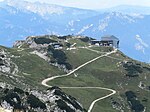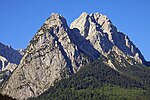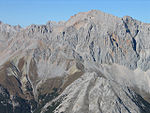Alpspitze
Mountains of BavariaMountains of the AlpsTwo-thousanders of Germany

The Alpspitze is a mountain, 2628 m, in Bavaria, Germany. Its pyramidal peak is the symbol of Garmisch-Partenkirchen and is one of the best known and most attractive mountains of the Northern Limestone Alps. It is made predominantly of Wetterstein limestone from the Upper Triassic.
Excerpt from the Wikipedia article Alpspitze (License: CC BY-SA 3.0, Authors, Images).Alpspitze
Südweststeig,
Geographical coordinates (GPS) Address Nearby Places Show on map
Geographical coordinates (GPS)
| Latitude | Longitude |
|---|---|
| N 47.429444444444 ° | E 11.0475 ° |
Address
Südweststeig
Südweststeig
82467
Bavaria, Germany
Open on Google Maps










